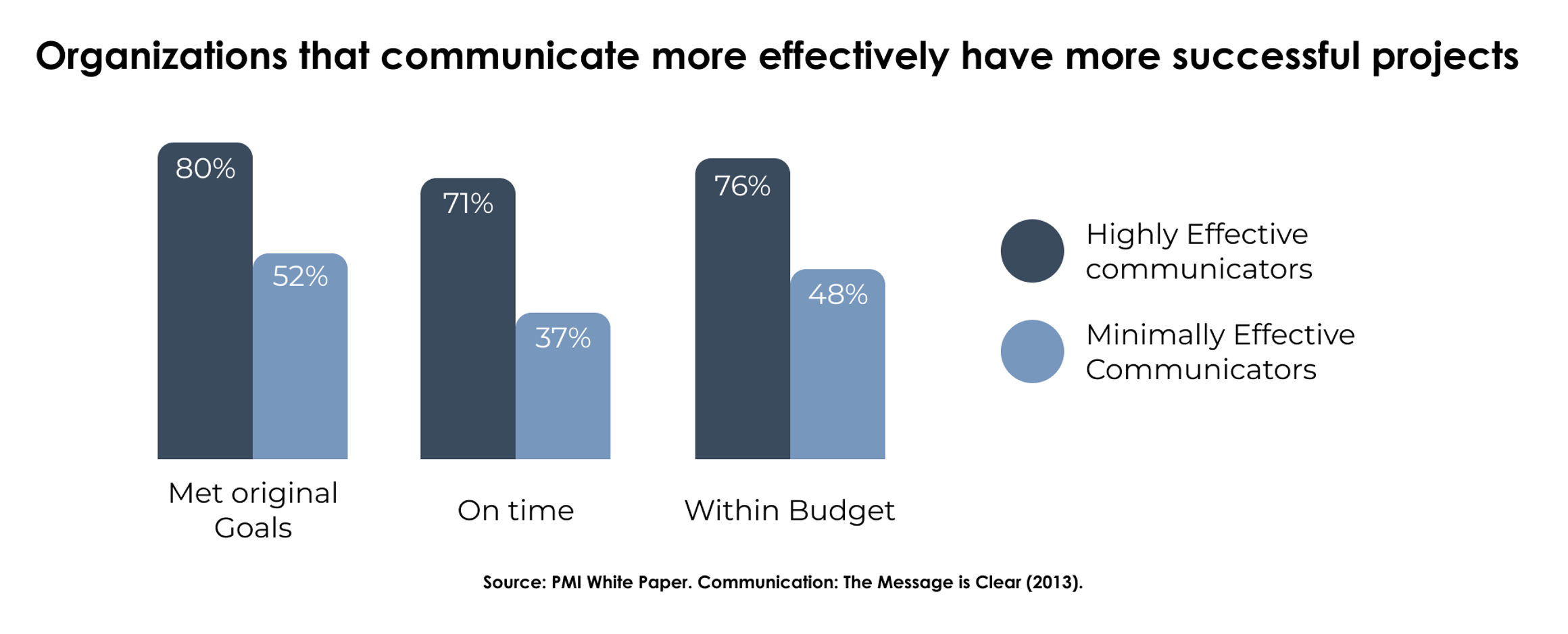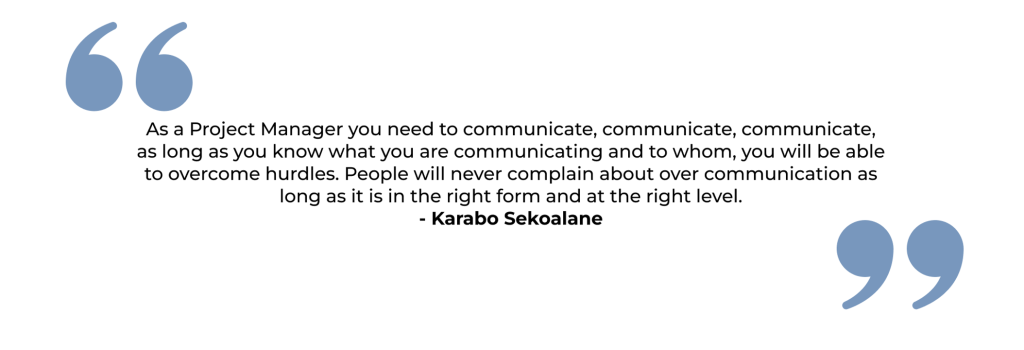Media
Tips and Strategies for Effective Communication in Project Management

Effective communication enables project managers to keep key stakeholders informed on the project status, progress, and any blockers. Through regular communications like email and face to face updates, presentations, and data visualizations, project managers can mitigate confusion and align understanding among diverse stakeholder groups.
Once a project launches, agreeing to a social contract around communication cadences allows stakeholders to monitor work streams, track progress toward goals, and stay up-to-speed without getting bogged down in the details. When done well, communication builds alignment on objectives and equips geographically distributed stakeholders with the knowledge needed to support the project team.
In summary, ongoing communication is vital for setting expectations, reporting progress, managing changes and issues, and enabling stakeholder participation – all critical ingredients for project success. Investing in clear, consistent communication ultimately saves time, reduces risks, and accelerates results.

Common Communication Challenges for Project Managers
The one challenge that stands out, is lack of structure within a project. Without a defined structure in a project, confusion can arise. Project sponsors typically play a crucial role in establishing this structure. Clear communication regarding the project’s goals, timelines, and affected parties is essential. A well-defined structure helps mitigate risks by providing a framework.
Furthermore, structure facilitates support from relevant stakeholders. When their roles are clearly defined, and they understand the project’s objectives, it enhances their engagement and contribution to the project’s success.
Identifying and Prioritizing Stakeholders
Project managers should prioritize stakeholders based on strategic alignment and level of involvement needed at each phase. Identify stakeholders required for each sprint of the project and ensure that those stakeholders that are required, are allocated to the correct sprint. Frameworks like SAFe Agile, ensures that strategies are being set and prioritized based on the business strategies.
Fostering open and transparent communication within project teams
At the project’s outset, a social contract is established, outlining meeting schedules and the types of documentation, including a project tracker (KANBAN), requirements documents, and more. Documentation, such as presentations and graphs, plays a massively important role to assist in communication. It is an effective way to communicate the details of the project to the different stakeholders. Notably, none of these documents reside on personal machines; instead, they are stored in the cloud, ensuring universal access for all project team members and stakeholders. This structured and collaborative approach not only facilitates effective communication but also lays the foundation for continuous improvement throughout the project lifecycle.
To monitor progress and discuss the project’s status, daily/weekly stand-up meetings are conducted. To ensure that we are effectively managing the project we would track our progress of the process velocity. Following the SAFe Agile method, will recommend doing demo’s for your project to the different stakeholders, this ensures that the project is on the right track and that the project team is meeting expectations. Communication is key on any project, extending beyond a purely business focus to foster personal connections and build strong relationships with team members. Continuous improvement of the project communication involves continuously going back to ensure that you are meeting the project expectations.
Bridging cultural divides for clear communication in diverse project teams
Immerse yourself in the culture of the people you work with and take the time to educate yourself about their cultural holidays. For instance, I recently learned about Diwali, rangoli and the unique ways it is celebrated in India, where rangoli means an array of colours and is a traditional Indian art form dating back some 5 000 years to the pre-Aryan period.
Bridging cultural gaps starts with fostering respect. Before meetings, initiate informal conversations about personal lives. Share aspects of your own life to demonstrate transparency and build relationships. This, in my experience, is a key step in bridging cultural divides.
Leveraging technology for project communication
Often, emails serve as a daily or weekly means of conveying essential project information to various stakeholders. Utilizing a variety of technologies can enhance communication. For instance, Microsoft Teams facilitates instant and consistent communication, WhatsApp is effective for providing real-time updates and notifying stakeholders of urgent issues that might require the stakeholder’s immediate attention, and OneNote and Obsidian can be utilized to inform team members of their specific tasks while tracking the progress of these assignments.
Maintaining effective communication during project challenges and changes
As a Project Manager, I’ve come to realize the importance of continuous and sometimes even ‘over-communicating.’ Sharing information with project stakeholders isn’t just a requirement; it’s proven to be an effective strategy for addressing challenges. Over the years, I’ve learned that the project isn’t solely mine; it’s a collective effort. This understanding means I’m not alone, and I don’t have to bear all the risks by myself. It’s has been a personal journey of not taking everything to heart and realising that I require a supportive team to share the responsibilities.
Lessons learned that influenced my communication strategies
C.Y.B. – Cover Your Back. I appreciate the concept, although it can sometimes feel like a mere tick-box exercise. However, with projects, emotions often run high, documenting every discussion is vitally important. Even seemingly insignificant conversations can impact the project, therefor I note down all conversations in black and white. A simple email, stating “As we discussed earlier” will suffice. The risk of ‘corporate amnesia,’ where past discussions are forgotten, is mitigated when everything is documented.
A personal example: I took over a delayed project and, by committing to daily communication, I kept the project sponsors informed, even during challenging phases. Despite not making the desired progress initially, the sponsors appreciated the transparency through the continuous communication. The sponsor also realized the complexity of project management and acknowledged the value of staying informed. This experience underscores the significance of simple yet consistent communication in making a considerable difference.
Advice and essential skills for aspiring Project Managers
Aspiring project managers can enhance their communication skills by understanding that effective communication is an art encompassing more than just sending emails. It involves documentation, graphs, and the ability to tailor communication to specific audiences. Again, I want to emphasize the importance of communicating with the right people and ensuring clear documentation. Discussion minutes can be another great tool for past discussions that took place and refreshing the memory of the stakeholders, recordings of meetings can also be effective, however you would need to know exactly where in the recording you need to skip to for a recap.
Another essential skill for successful communication in project management is confidence. Project managers need to be confident in their ability to communicate verbally and through presentations. Active listening is equally important, as it enables you to grasp the points stakeholders are conveying. Establishing communication boundaries while maintaining an open atmosphere encourages people to share information comfortably, providing valuable insights for project progression. Ensure that you thoroughly prepare before meetings, this will ensure that you are confident, but also allow room for discussion after your presentation. Preparation not only instils confidence but also guides the conversation in the direction where you receive all of the information that you needed to achieve for that meeting. Make each interaction an opportunity for effective communication and project advancement.

About Karabo
Karabo is a Project Manager at CyberPro Consulting currently deployed to Stanlib. He has over a decade of experience in project management across various industries, including banking, short-term insurance, corporate action, and asset management. He holds an International Diploma in Project Management from Cambridge as well as professional certifications in Agile, PRINCE2, and Scrum methodologies. Karabo believes in socializing project management across business units by collaborating with different stakeholders such as business analysts, product owners, customer experience specialists and more, to gather requirements. He engages in continual learning through training and refresher courses in frameworks like SAFe and Scrum to strengthen his project management expertise.
We can help you grow your business

Driven by a commitment to client satisfaction, collaboration, and cutting-edge solutions.
Years Experience

Delivering excellence through decades of expertise, innovation, and trusted solutions.
